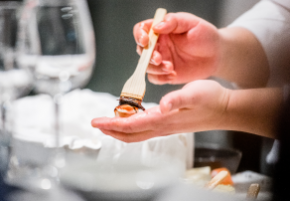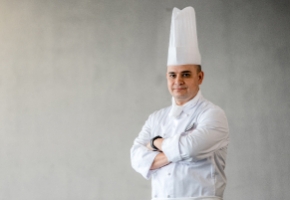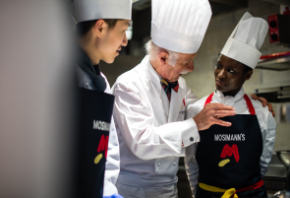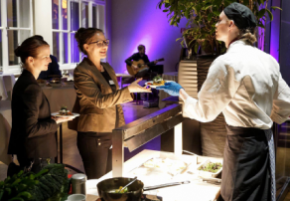- About
- Programs
- Campus Life
- Career Services
- Admissions
- News & Events
- Alumni
Types of Ramen: Discover the Unique Broths and Noodles
From Shio to Miso, discover the different types of ramen, their flavors, regional origins, and the toppings that make each bowl a delicious experience.
Key Takeaways
- Ramen is a popular noodle dish made with noodles, broth, and various toppings.
- The main types of ramen include Shio, Shoyu, Miso, and Tonkotsu, though other varieties also exist.
- Ramen noodles are made from wheat flour, water, salt, and kansui, and they can vary in thickness, texture, and shape.
There's something so comforting about a bowl of ramen. It has definitely become one of the most popular types of noodles across the globe.
For some, ramen is a cherished part of family traditions, shared around the table. For others, it's the joy of slurping noodles alongside their favorite anime characters, who often turn to ramen for comfort or celebration. For many students, it's a go-to meal—warm, satisfying, and budget-friendly.
There are many different types of ramen, each with its own ingredients and style—comforting and simple, luxurious, warm, flavorful, and convenient all in one.
Types of Ramen
While ramen noodles are often said to have roots in Chinese cuisine, it’s actually Japanese cuisine that has become synonymous with them and has introduced some of the most iconic ramen recipes.
Different ramen types vary in taste, texture, preparation techniques, and presentation. Some of the most notable and beloved types of ramen include:
Shio
Shio ramen is one of the most delicate and lightest forms of ramen. It's often referred to as "salt ramen" because its broth is usually seasoned only with salt.
The noodles are generally straight, thin, and firm, complementing the broth without overpowering it. This type of ramen is often topped with simple ingredients like green onions, bamboo shoots, and slices of chicken or chashu pork.
Tonkotsu
This ramen, originally from Fukuoka, features a rich, creamy broth made from boiling pork bones until the collagen and marrow dissolve into a milky consistency.
The noodles are ultra-thin and firm, traditionally served with toppings like wood ear mushrooms, pickled ginger, and soft-boiled eggs.
Shoyu
Shoyu ramen originated in Tokyo and remains one of the most common ramen styles across Japan. It incorporates a broth that is often a combination of chicken, pork, or vegetable stocks, elevated by the addition of quality soy sauce.
The noodles are usually medium-thin and curly. Toppings may include menma (fermented bamboo shoots), nori, green onions, and soft slices of pork.
Miso
Miso ramen is a specialty of Hokkaido, particularly in the city of Sapporo. The broth of this type of ramen is thick, hearty, and packed with a deep, savory-sweet flavor thanks to the addition of fermented soybean paste. Its broth pairs particularly well with thicker, curly noodles that can hold the bold flavors.
It's prepared by sautéing miso with garlic and vegetables and then adding the stock and toppings like corn, butter, bean sprouts, or ground pork.
Kurume
Kurume, hailing from the city of Kurume in Fukuoka Prefecture, is a variation of tonkotsu ramen with an even deeper and more concentrated pork bone flavor, sometimes achieved through the so-called "yobimodoshi" method, where the broth is reused and enriched over time.
The broth is thick, rich, and aromatic, with noticeable pork fat on the surface. The noodles are thin and slightly softer than those in standard tonkotsu ramen. Some traditional toppings include scallions, pickled ginger, and garlic chips.
Kagoshima
Kagoshima ramen, originating from the southern region of Kagoshima, features a slightly cloudy broth made from a blend of pork, chicken, and vegetables. In contrast to the sharp saltiness found in most other tonkotsu-based broths, Kagoshima ramen offers a mild, sweet flavor with a light, clean aftertaste.
The noodles are of medium thickness and slightly soft, while the toppings typically consist of bean sprouts, cabbage, chashu pork, and pickled mustard greens.
The preparation of this ramen dish emphasizes gentle simmering, allowing flavors to develop slowly. This ramen type is perfect for those seeking a satisfying yet not overly heavy bowl.
Hakata
Hakata ramen, originating from the Hakata district in Fukuoka, is famous for its thick, creamy tonkotsu broth that remains light on the palate. The noodles are extremely thin, straight, and cooked to a firm texture, often served with the option for "kaedama," an extra serving of noodles to add to the remaining broth.
The broth is prepared by boiling pork bones at high heat for hours until it reaches the desired richness. Toppings include finely sliced green onions, kikurage (wood ear) mushrooms, and marinated eggs.
Sapporo
Sapporo ramen is synonymous with miso-based broths but can also feature shio or shoyu variations, in which case the miso is replaced with either salt or soy sauce. The broth tends to be hearty, with a nutty and savory richness that warms the body during cold winters.
It's traditionally prepared by frying vegetables in lard and then adding the miso broth. The thick, wavy noodles are used to hold up the broth and are often paired with butter, corn, bean sprouts, and ground pork.
Asahikawa
Asahikawa ramen, also from Hokkaido, is known for its unique shoyu-based broth that is further enriched with pork, chicken, and seafood stock. This specific ramen type is unique as it incorporates a thin layer of oil on top.
The noodles used for this type of ramen are medium-thin, wavy, and chewy, and the toppings can be bamboo shoots, green onions, or slices of pork.
Tomato
Tomato ramen is a modern take on traditional ramen that features a broth made from fresh tomatoes blended with chicken or seafood stock. It has a fresh, tangy, and slightly sweet flavor with a hint of umami.
This ramen uses thin, straight noodles that are then garnished with basil, Parmesan cheese, or olive oil in a way that leans toward Italian-Japanese fusion.
Kitakata
Kitakata ramen comes from Fukushima Prefecture and is known for its light shoyu broth with a subtle pork flavor. The noodles are wide, flat, and chewy with a broth, typically made from pork bones and soy sauce, which is clear but rich in umami.
Common toppings for this type include narutomaki (fish cake), green onions, bamboo shoots, and slices of pork.
Tantanmen
Tantanmen, or Tan Tan ramen, is the Japanese take on the famous Chinese Sichuan dan dan mian, featuring a spicy, creamy broth made from sesame paste, soy sauce, and chili oil. The broth for this type of ramen is bold, rich, and full of complex flavors with a lingering heat.
The noodles are medium-thin and straight with toppings such as minced pork, green onions, and soft-boiled eggs. Some variations also add leafy greens or crushed peanuts for added texture.
Onomichi
Onomichi ramen, from Hiroshima Prefecture, features a shoyu-based broth with chicken stock and a noticeable layer of pork back fat floating on the surface. This fat adds richness and depth to balance the sharpness of the soy sauce.
The noodles are medium-thick and flat, and the toppings usually include chashu pork, green onions, and bamboo shoots.
Wakayama
Wakayama ramen is made of tonkotsu-shoyu broth. It combines the richness of pork bones with the salty tang of soy sauce and thin, straight noodles, served with slices of pork, green onions, and bamboo shoots.
Preparation often involves a long simmering of pork bones with aromatic vegetables, followed by careful seasoning with high-quality soy sauce.
Taiwan
Despite its name, Taiwan ramen was not created in Taiwan but in Nagoya, Japan. However, it features Taiwanese-style spice and flavor with a bold, spicy broth made with soy sauce, garlic, chili peppers, and minced pork.
That broth is combined with medium-thin, straight noodles and toppings like garlic chives, green onions, and sometimes bean sprouts.
Exploring the Varieties of Ramen Noodles
Ramen noodles are typically made from wheat flour, water, salt, and kansui, an alkaline water that gives the noodles their signature chewy texture and slightly yellow color.
The dough made from those ingredients is rolled out and cut into long strands, which are then pressed into various shapes. These differences in thickness and shape impact not only the appearance of the noodles but also their texture when eaten and their ability to hold onto the broth.
There are various types of noodles used for the different kinds of ramen. These noodles include:
- Thin noodles, which pair well with light, clear broths as they absorb flavors quickly.
- Thick noodles, ideal for rich, heavy broths, as they hold up well to the weight of the broth.
- Wavy noodles, great for catching bits of flavor and toppings.
- Straight noodles, perfect for light broths that need a smooth texture.
- Egg noodles, made with added egg or yolk, offer a springy and soft texture.
A Flavorful Exploration of Ramen Types
Ramen is a clear example of how limitless creativity can be in the kitchen. Considering the variety in noodles, broths, and even toppings, the combinations are nearly endless. Balancing these flavors is a skill that takes both passion and guidance to master.
At the Culinary Arts Academy Switzerland (CAAS), this balance is taught through theory, hands-on experience, and world-class instruction. CAAS offers a wide range of culinary courses and programs that are designed to help students develop their palate, technique, and creativity.
Two such programs offered are the Bachelor of Arts in Culinary Arts, which allows students to explore in-depth culinary techniques, kitchen management, and innovation, and the Swiss Diploma in Culinary Arts, ideal for those seeking professional, intensive training in cooking. What's more, students have the opportunity to participate in the International Recruitment Forum (IRF), where they can connect with global hospitality and culinary leaders.
So, if you're ready to learn, create, and master flavor, join us at CAAS and start stirring your own pot of success.
Frequently Asked Questions
How many types of ramen are there?
There are four main types: shio (salt), shoyu (soy sauce), miso, and tonkotsu (pork bone). However, many variations of them exist.
What is the most popular style of ramen?
Tonkotsu ramen is one of the most popular, known for its rich, creamy pork-based broth.
What type of noodles are used in ramen restaurants?
Most ramen restaurants use wheat-based noodles made with kansui, available in varying thickness and shapes to complement the broth.
Interested in studying at CAAS? Download our brochure to learn about our programs!




























